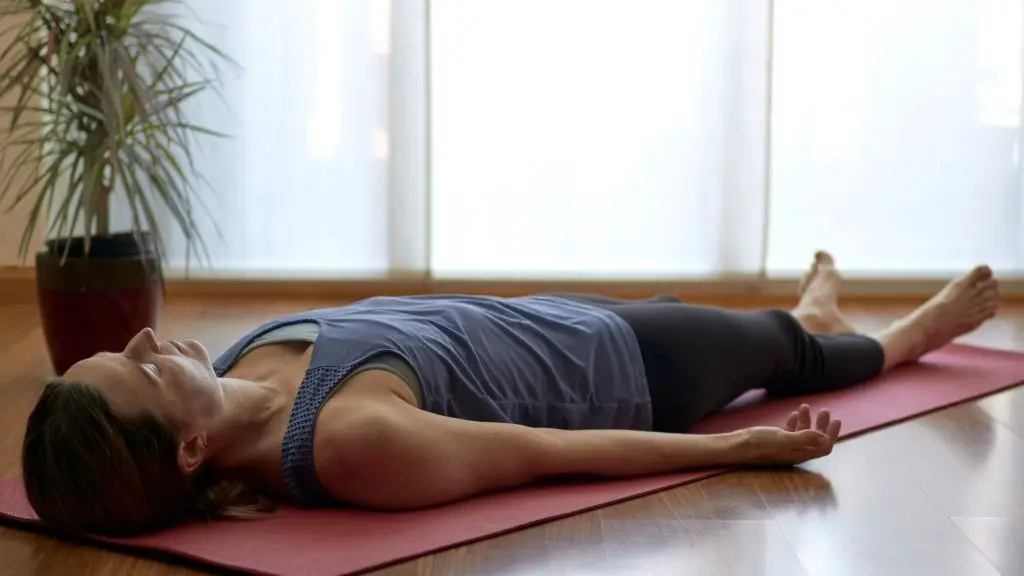Is Sleep a Form of Meditation? Exploring the Connection

“Tap into your subconscious and experience the benefits of everything it has to offer.” Is sleep a form of meditation or not is a question that still boggles us, but Yoga Nidra might just be the answer to that! Read on to find out more!
When we sit to meditate, we settle down, get comfortable, close our eyes and essentially just empty our heads of all thoughts and focus on one thing. If you’re familiar with guided meditation, this one thing is most probably the light of a candle you picture. This whole process of settling down and meditating must sound familiar, which is why this one particular question might pop up in your head.
What question, you ask?
Is sleep a form of meditation? This question doesn’t necessarily have one answer. Some might say meditation can be a powerful tool that might aid you in getting better sleep, but it isn’t the same thing. In contrast, others might say that sleep can be a form of meditation that goes by Yoga Nidra, which essentially just means sleeping in Sanskrit. So let’s break this down and see what sleep meditation is and if sleep and meditation are the same things.
Is Meditation a Form of Conscious Sleep?
Conscious sleep, also termed hypnagogia, is the transitional period between wakefulness and deep sleep. This is the period where you might hallucinate experiences, sounds, and other reactions. Sleep paralysis often occurs during this period.
When you’re falling asleep, the alpha and beta waves that your body produces drop, and within the first 5 minutes, your alpha waves drop to less than 50% of your total brain waves. During this dropping process, you slip into conscious sleep; your alpha waves are decreasing, but you haven’t quite reached the first stage of sleep.
Now when you’re sitting to meditate and are slipping into a meditative state, your beta waves drastically reduce, and your alpha waves show an increase in production. To understand the significance of what that means, it’s essential to know what each of these waves means. Alpha waves are seen in an individual when they’re in a normal wakeful state and are resting or stress-free in a sense; beta waves are present when an individual is intensively thinking about something, problem-solving, or is just super alert and attentive.
To answer whether meditation is a form of conscious sleeping isn’t a simple yes or no. When you’re in the state of conscious sleep, your alpha waves are decreasing, and the body is preparing itself to enter the state of deep sleep, but when you’re meditating, your alpha waves increase, which goes to say that you are still very much awake but are just more relaxed. Maybe you could consider meditation a form of conscious sleeping if you were equally awake and aware during that stage.
Difference between Sleep and Meditation
Although sleep and meditation can feel similar in many ways, they are actually two very distinctive states.
If we were to point out differences between the two, we would do so on these three grounds
- Mood after
- Breathing pattern
- Awareness and consciousness
Mood after
If you’ve noticed, you often feel dull and aren’t very energized right after you wake up. However, you are most likely to feel like your best self after meditation. You’ll have a sense of peace and clarity and will be positively energized; all of this is due to the endorphins that are released when you’re meditating.
Breathing pattern
When you’re asleep, it is normal for your breathing to slow down, but not in terms of oxygen production. Your breathing might slow down and get a lot deeper, but your oxygen intake will not vary as much. However, when you meditate, your mind quietens, and as a result, your body requires less oxygen. The breathing rate starts diminishing dramatically; studies have shown that yogis and professional meditators can control their mind and body to an extent where they can voluntarily slow down their physiology.
Awareness and consciousness
Our mind comprises three parts, the conscious, subconscious, and the unconscious. When we are asleep, we are aware of our mind’s unconscious and subconscious parts. However, since we aren’t awake, we can not make use of the benefits that the subconscious offers.
When we meditate, we are aware of our minds’ conscious and subconscious parts. We are awake and aware of ourselves and our subconscious, which can help us with our creative side, intuition, intelligence, and all that good stuff.
Can you Convert Sleep into Meditation?
To convert sleep into meditation, you will have to wake up, which ruins the purpose of converting sleep into meditation.
Can you replace sleep with meditation?
Definitely.
Depending on how many hours of sleep you got and how much time you have on your hand, you can substitute sleep with meditation to energize your body and get on with your day without any lethargy. You could also try sleep meditation, also known as Yoga Nidra.
What is Sleep Meditation?
Yoga Nidra or sleep meditation is a state of consciousness between wakefulness, and deep sleep that guided meditation helps you achieve. Your body is completely relaxed in this state while your mind is still aware of your subconscious. Yoga Nidra is one of the deepest possible states of relaxation wherein you can still maintain full consciousness.
Apart from the states of consciousness that differ between the act of sleeping and practicing Yoga Nidra, another key difference is that your subconscious can not get rid of your worries and stress when you’re asleep; however, it can do so when you’re practicing Yoga Nidra.
Benefits of Sleep Meditation
Practicing Yoga Nidra on a schedule, same day-same time is the best way to reap its benefits. Sticking to a regular pattern is the correct way to practice this form of meditation.
Some of the benefits of practicing Yoga Nidra are,
- Relaxes the mind
- Helps foster creativity
- Releases tension from the mind and body
- Counteracts stress [1]
- Provides effective relief from depression and anxiety [1]
- Clears the mind
- Helps absorb new information
- Promotes good sleep
How to Practice Sleep Meditation?
Yoga Nidra is a form of guided meditation; this means that you will receive directions from an external source who will help you achieve the state of relaxation you desire.
It usually takes anywhere between 45 minutes to an hour.
Steps to follow while practicing Yoga Nidra
- Release all tension from your body, loosen up, and settle down in a quiet place.
- Have a goal in mind—a goal you’d want to achieve in this session.
- Direct your mind to focus on every part of your body, relax it, and make yourself aware of its function.
- Breathe slowly and only through your nostrils. This will help you feel light and as though you have no control over your body.
- Focus and think about all happy and positive things, feelings, and emotions.
- Visualize and place yourself in a happy environment in your mind to release whatever tension that might be holding you back.
FAQs
Q: Will meditation affect my sleep?
A: Yes, meditation will affect your sleep. But in a more positive sense. Practicing meditation regularly can help induce deep sleep. You will wake up energized and ready to conquer the day.
Q: How long can I meditate for?
A: Meditation has no time limit. You can meditate for as long as you want or for as short a period. Your goal through meditation is to attain a sense of peace and calm, and to do that, you do not require any limitations whatsoever.
Q: Is there a set time to practice Yoga Nidra?
A: No, there isn’t a set time to practice Yoga Nidra. You can do this at any time of the day. However, make sure to stick to a routine to attain the benefit of this practice.
Wrapping up
Sleeping and meditation are so similar yet so different. Each of them with its benefits. Can we combine the two and reap the benefits of both? Yes. That is precisely where Yoga Nidra steps in.
Yoga Nidra is a guided meditation that can make you aware of your subconscious while also helping you relax. Practicing it will not only help you sleep well but will also help you get in touch with your intuition, creative side, intellectual side, and so on.
But to answer the question, “is sleep a form of meditation?” we’d say yes, and no. There are quite a few blurred lines when we broach this topic, but essentially sleep and meditation can be similar and can be considered the same thing but have three significant differences that you can not turn a blind eye to.
So what do you think? Is sleep a form of meditation? Let us know in the comments below, and while at it, head over to Benefits of Daily Yoga if yoga is something that interests you!







